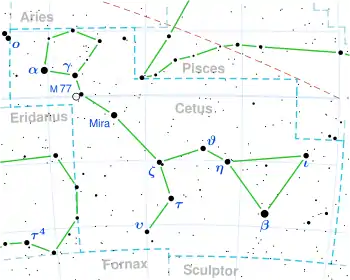49 Ceti
49 Ceti is a single[9] star in the equatorial constellation of Cetus. It is visible to the naked eye as a dim, white-hued star with an apparent visual magnitude of 5.607.[2] The star is located 186 light-years (57 parsecs) away from the Solar System, based on its parallax,[1] and is drifting further away with a radial velocity of +10 km/s.[5] 49 Ceti has been identified as a member of the 40-million-year-old Argus Association.[8]
 | |
| Observation data Epoch J2000 Equinox J2000 | |
|---|---|
| Constellation | Cetus |
| Right ascension | 01h 34m 37.77883s[1] |
| Declination | −15° 40′ 34.8981″[1] |
| Apparent magnitude (V) | 5.607[2] |
| Characteristics | |
| Spectral type | A1V[3] |
| U−B color index | +0.05[4] |
| B−V color index | +0.07[4] |
| Astrometry | |
| Radial velocity (Rv) | +10.30±0.7[5] km/s |
| Proper motion (μ) | RA: 94.207[1] mas/yr Dec.: -3.165[1] mas/yr |
| Parallax (π) | 17.5234 ± 0.1001 mas[1] |
| Distance | 186 ± 1 ly (57.1 ± 0.3 pc) |
| Details[6] | |
| Mass | 2.02 M☉ |
| Luminosity | 19.12 L☉ |
| Surface gravity (log g) | 4.30[7] cgs |
| Temperature | 8,790 K |
| Metallicity [Fe/H] | 0.10 dex |
| Rotational velocity (v sin i) | 196 km/s |
| Age | 40[8] Myr |
| Other designations | |
| Database references | |
| SIMBAD | data |
This is a young A-type main-sequence star with a stellar classification of A1V.[3] It is about 40[8] million years old with a high rate of spin, showing a projected rotational velocity of 196 km/s.[6] The star has double the mass of the Sun.[6] It is radiating 19 times the Sun's luminosity from its photosphere at an effective temperature of 8,790 K.[6]
49 Ceti displays a significant infrared excess, which is a characteristic of a debris disk orbiting the star. Unusually, the disk seems to be gas-rich, with evidence of carbon monoxide (CO) gas. This carbon monoxide gas may possibly be from comets orbiting the star within the disk, similar to the Kuiper Belt in the Solar System.[8]
References
- Brown, A. G. A.; et al. (Gaia collaboration) (August 2018). "Gaia Data Release 2: Summary of the contents and survey properties". Astronomy & Astrophysics. 616. A1. arXiv:1804.09365. Bibcode:2018A&A...616A...1G. doi:10.1051/0004-6361/201833051. Gaia DR2 record for this source at VizieR.
- Høg, E.; et al. (2000). "The Tycho-2 catalogue of the 2.5 million brightest stars". Astronomy and Astrophysics. 355: L27–L30. Bibcode:2000A&A...355L..27H.
- Roberge, A.; Kamp, I.; Montesinos, B.; Dent, W. R. F.; Meeus, G.; Donaldson, J. K.; Olofsson, J.; Moór, A.; Augereau, J.-C.; Howard, C.; Eiroa, C.; Thi, W.-F.; Ardila, D. R.; Sandell, G.; Woitk e, P. (2013). "Herschel Observations of Gas and Dust in the Unusual 49 Ceti Debris Disk". The Astrophysical Journal. 771 (1): 69. arXiv:1305.2894. Bibcode:2013ApJ...771...69R. doi:10.1088/0004-637X/771/1/69. S2CID 1630036.
- Rybka, E. (1969). "The corrected magnitudes and colours of 278 stars near S.A. 1-139 in the UBV system". Acta Astronomica. 19: 229. Bibcode:1969AcA....19..229R.
- Gontcharov, G. A. (2006). "Pulkovo Compilation of Radial Velocities for 35 495 Hipparcos stars in a common system". Astronomy Letters. 32 (11): 759–771. arXiv:1606.08053. Bibcode:2006AstL...32..759G. doi:10.1134/S1063773706110065. S2CID 119231169.
- Zorec, J.; Royer, F. (2012). "Rotational velocities of A-type stars. IV. Evolution of rotational velocities". Astronomy & Astrophysics. 537: A120. arXiv:1201.2052. Bibcode:2012A&A...537A.120Z. doi:10.1051/0004-6361/201117691. S2CID 55586789.
- Pawellek, Nicole; et al. (September 2014), "Disk Radii and Grain Sizes in Herschel-resolved Debris Disks", The Astrophysical Journal, 792 (1): 19, arXiv:1407.4579, Bibcode:2014ApJ...792...65P, doi:10.1088/0004-637X/792/1/65, S2CID 119282523, 65.
- Zuckerman, B.; Song, Inseok (2012). "A 40 Myr Old Gaseous Circumstellar Disk at 49 Ceti: Massive CO-Rich Comet Clouds at Young A-Type Stars". The Astrophysical Journal. 758 (2): 77. arXiv:1207.1747. Bibcode:2012ApJ...758...77Z. doi:10.1088/0004-637X/758/2/77. S2CID 119198485.
- Eggleton, P. P.; Tokovinin, A. A. (September 2008). "A catalogue of multiplicity among bright stellar systems". Monthly Notices of the Royal Astronomical Society. 389 (2): 869–879. arXiv:0806.2878. Bibcode:2008MNRAS.389..869E. doi:10.1111/j.1365-2966.2008.13596.x. S2CID 14878976.